Kids turning off the TV, turning on the PC
To the delight of many parctines dramatically when children have a PC available to use at home, according to findings from The American Learning Household Survey, a new study from FIND/SVP and Grunwald Associates. The study concludes that a major trend is in the making that could see TV use decline even more dramatically in the future. The trend is driven by increasingly affordable and innovative PC technology and software content, spurred by a widespread belief among parents that they must supplement what is being taught at school.
The nine-month study was sponsored by over 20 U.S. learning, computer industry and media companies. Research began with 12 focus groups with parents and children in early 1995, followed by a survey of 1,200 family households using an in-depth 35-minute questionnaire. Topics covered in the study include television viewing, on-line and Intemet use, home PC hardware and software applications, household spending on learning resources, and parental interest in using a range of emerging interactive learning content and equipment. The error margin of the statistical data is +/- 2.8 percent at the 95 percent confidence level.
Parents in nearly two-thirds of family PC households report that their children watch less TV as a direct result of using the PC, rising to nearly three-quarters of households that own a multimedia PC equipped with a CD-ROM drive.
"The survey shows that new forms of information-intensive learning are moving rapidly into the home," says Thomas E. Miller, vice president of the Emerging Technologies Research Group at FIND/ SVP, New York. "The really good news is that kids, themselves, are choosing to watch less TV once they get their hands on a PC," he adds. The study found that over 80 percent of parents interviewed who planned to purchase a home PC stated that their children’s education was a primary reason for purchasing.
One very surprising finding of the new study is that young girls actually spend more time using home PCs than young boys. However, their use of PCs eventually declines. "Sometime between the fourth and seventh gade, girls’ use of home-PCs begins to trail off, just like their much discussed tendency to become less involved in math studies," says Peter Grunwald, president of Grunwald Associates and the lead educational consultant on the study. "This finding is especially important because it belies the stereotype that girls don’t like PCs as much as boys, and it also links the issue to the larger question of why girls' interests appear to shift so dramatically as they mature."
The study also found that mothers are now as likely as fathers to use PCs at home in family households, and they are very much involved in making home PC purchase decisions. Women in 33 percent of family PC households now say they use the PC for activities that include running home businesses, keeping track of household budgets, personal learning activities, on-line searching and volunteer activities. By comparison, adult males were found to use PCs at home in only 32 percent of family PC households, primarily for work-related activities.
Children aren’t just dropping TV to play games on home PCs, although games are the single home PC application used most often by children. Parents estimate that under 40 percent of children’s total PC time is used for games. Most time is spent writing homework papers and exploring information, including 14 percent of family PC households where children now use on-line services.
"One of the most interesting findings is that children also like to collaborate on PCs at home," says Grunwald. The data show that brothers and sisters do activities together on home PCs in 45 percent of family PC households. Meanwhile, parents in nearly a third of all family households indicated that household members use PCs at other peoples’ homes. These findings contradict the widely held view that PCs and on-line services tend to isolate people by creating a new reason to stay at home and not mix with others. In fact, the study finds that children who go on-line are actually more likely to be involved in sports, outside activities, volunteer activities and private lessons like music or dance.
Florida remains most popular place to move
A nationwide poll asking Americans which state they would most like to move to shows Florida to be the top choice, according to Decision Analyst, Inc., an Arlington, Texas, marketing research firm. In a survey of more than 10,000 Americans, Florida was picked by 9.1 percent of the respondents. Those favoring Florida tended to live in the Northeast, were 35 to 54 years old, and earned more than $40,000 per year, In terms of education, the survey showed most of those selecting Florida had a high school education or less.
Ranked second in the survey was Colorado, selected by 7,6 percent of respondents. Those favoring Colorado were more likely to be from the Midwest and be between the ages of 35 and 44. They most likely earned $40,000 or more and had at least some college education.
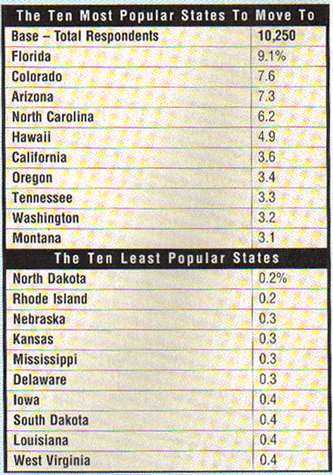 In a similar survey conducted by Decision Analyst, Inc, last year, Florida was followed in order by Arizona, Hawaii, Colorado andNorth Carolina as the five states where Americans would most like to move. This year the top five shifted slightly, with Florida and Colorado followed by Arizona (7.3 percent), North Carolina (6.2 percent) and Hawaii (4.9 percent).
In a similar survey conducted by Decision Analyst, Inc, last year, Florida was followed in order by Arizona, Hawaii, Colorado andNorth Carolina as the five states where Americans would most like to move. This year the top five shifted slightly, with Florida and Colorado followed by Arizona (7.3 percent), North Carolina (6.2 percent) and Hawaii (4.9 percent).
Moving up appreciably this year to sixth place was California, ranked 11 th in last year’s survey. Rounding out this year’s top 10 were Oregon, Tennessee, Washingon and Montana, respectively. The slightly different top 10 showed that Texas fell from the seventh spot last year to 11th this year, and South Carolina dropped from the 10th spot last year to 13th this year.
Some of this year’s least favored states were Mississippi, Kansas, Nebraska, Rhode Island and North Dakota. "It isn’t too difficult to understand why Florida and Colorado were favored, given the combination of recreational and economic opportunities those states offer," says Jerry W. Thomas, president of Decision Analyst, Inc. "There are some anomalies, however, such as Texas and South Carolina slipping out of the top 10. Texas is one of the fastest growing states, and South Carolina has an economy that is quite strong.
"Apparently what is happening is that a higher-quality lifestyle - less congestion, cleaner air, more recreational opportunities, etc. - is proving more and more attractive to the average American. Yet, it’ s still job opportunities that dictate where we must live. This survey indicates preferences, but not always population migration patterns."
In its survey, Decision Analyst asked the question: "If you had an opportunity to move to another state, which one state would you most like to move to?" The sample was balanced according to population. The statistical error was less than one percentage point, plus or minus.
Consumers fret over safety at ATMs
The public is increasingly aware, concemed and demanding of action to reduce the perceived risks of using automatic teller machines, according to findings of IssueTrack/ USA, an ongoing study by Audits & Surveys Worldwide (ASW), New York. After interviewing 1,200 randomly selected adults, 18 years of age or older, ASW noted that safety concerns have gown as shorter days force many customers to bank past daylight hours.
"Crime at or near ATM sites may not be on the rise, but public fear of ATM related theft is increasing significantly," says Bany M. Feinberg, seniorvice president and director of ASW’s Public Affairs Division. "Twenty-four hour ATMs are a boon to busy customers and significantly reduce transaction costs to banks and S&Ls, but the public is increasingly concerned about the possibility of unwanted transfers of money that do not appear on anybody’s books. Nearly one-quarter of those surveyed urgently want action taken to reduce the safety risks of using ATMs. Not surprisingly, the demand for increased security is more pronounced among women than men and among those in metropolitan areas than those living in rural communities."
The public is increasingly aware of the safety risks associated with using automatic teller machines...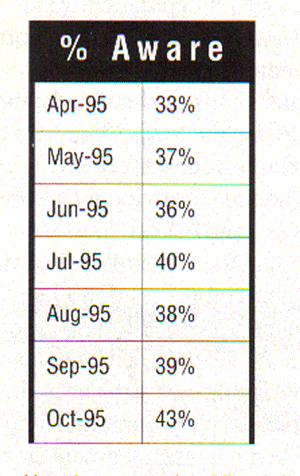
... and has become significantly more concerned with the issue of ATM safety as daylight hours get shorter.
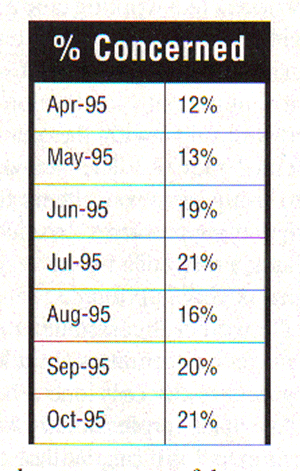
Nearly one-quarter of those surveyed urgently want action taken to reduce the safety risks associated with using ATMs.
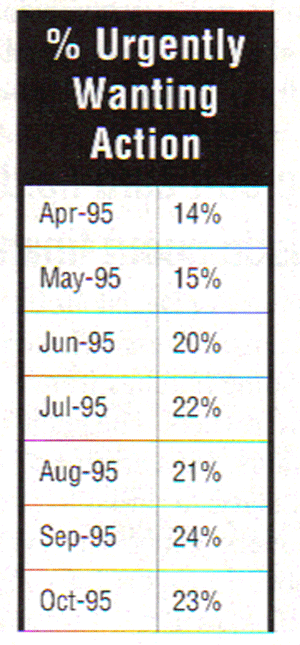
Survey looks at research and education habits of execs
Strategic Directions Group, Inc., a Minneapolis marketing consulting firm, recently completed its second study of U.S. marketing executives. This study of 390 marketing executives representing 381 of the largest U.S. companies and 24 industries was completed late in 1994. Two thousand eight-page questionnaires were mailed to achieve a response rate of 20 percent.
Among the issues the segmentation study addressed were marketers’ sources of information, goal setting and risk orientation. The study also focused on marketing executives’ openness to new ideas and methods in marketing.
The study categorized respondents into one of five segments that Strategic Directions Group developed in 1990. In the first study, respondents sorted a set of 77 statements on attitudes and motivations. The segments were determined from this process. The five attitudinally-based segments are the Sophisticates, Direct Answers, Mass Marketers, Constrained, and Networkers.
The Sophisticates very strongly believe that pursuing niches or sub-goups is central to their marketing strategy. They believe that target marketing is the most efficient way to reach profitability. The Sophisticates work in companies that are "looking for change and innovation."
Dedicated to keeping up on new developments and applications in marketing, the Sophisticates do so through reading industry publications. The Sophisticates are also committed to sending their managers to seminars and training progams, thus investing in their company’s future.
The Sophisticates rely more on external rather than internal data. They believe the research they’ve seen and agree that it gets used enough to be worth the money spent, however, the Sophisticates, along with the Constrained, appear frustrated by the lack of insight into their customers obtained from their current research.
Those in the Direct Answers segment believe most marketing consultants tell them what they already know. The Direct Answers consider most of the market research they see as neither believable nor actionable.
The research the Direct Answers tend to buy is straightforward. For marketers in the Direct Answers segrnent, a marketing niche is based on a two-dimensional view of the customer. This viewpoint "concentrates on a couple of key characteristics of buyers rather than on a sophisticated profile."
For the Direct Answers, attending as many professional development seminars as they can is not an important priority, nor do they try to send their managers to seminars or other training progams.
Of the five segments, the Mass Marketers least agee that marketing to niches can be profitable. Targeting niches is not central to this segment’s marketing strategy.
The Mass Marketers work at companies where decisions are based on "solid research data." As a computer-literate manager, the Mass Marketer feels capable of using "the most sophisticated information technology."
The Mass Marketer is satisfied with being on time and on budget; it is "the most important consideration" for his or her market research suppliers.
Of the five segments, only the Constrained agee that they don’t have "time to do research." The Constrained report that their department waits until the last minute to get needed information. In addition, although they would like to do more research they are prevented by their budgets.
Rather than gather external data, the Constrained’s department reiles primarily on an analysis of internal information and secondary research.
Of the five segments, only the Constrained and the Mass Marketers believe that focus goups produce "useful insights into the behavior and needs of our customers and buyers."
Those in the Constrained segment believe their companies don’t have the information needed to compete successfully in the 1990s. The Constrained exec does not see the company he or she works for as one open to change and innovation. A marketer in this segment is far less willing than those in the other segments to point out new directions to management.
Networkers like working elbow-to-elbow with the consultants they employ. More than the other segments, Networkers think it’s important "to develop longterm relationships with the marketing consultants" they use. The Networker is open to using new consultants to help solve marketing problems. In selecting a consultant, a reference from a respected colleague is very important.
The Networker is committed to sending managers to seminars. In addition, this segment is the only one which attends "as many professional development seminars" as it can. Willing to propose new directions to management, the Networker believes that using "new systems and techniques in looking at marketing problems" is one way to continue to grow on the job.
Most credit card holders optimistic about finances
Directions For Decisions Inc., a Jersey City, N.J., market research company, has released some findings from its study of credit card owners. The telephone study of 931 adults, 18 years of age and older, was conducted to provide a benchmark on consumers’ economic point-of-view and to obtain insights into attitudes toward credit card usage. Consumers were asked for perceptions about their job security, personal financial situation, disposable income; ownership and usage of national credit cads, attitudes toward credit card debt and the current business climate.
Job confidence - A majority feel strongly that their job is secure. A third are only fairly confident in the future of their employment and 8 percent feel in jeopardy of being unemployed.
Personal financial situation - Younger consumers perceive their personal financial situations have improved over the past year. Those 50+ were most likely to feel their personal financial situations remain unchanged.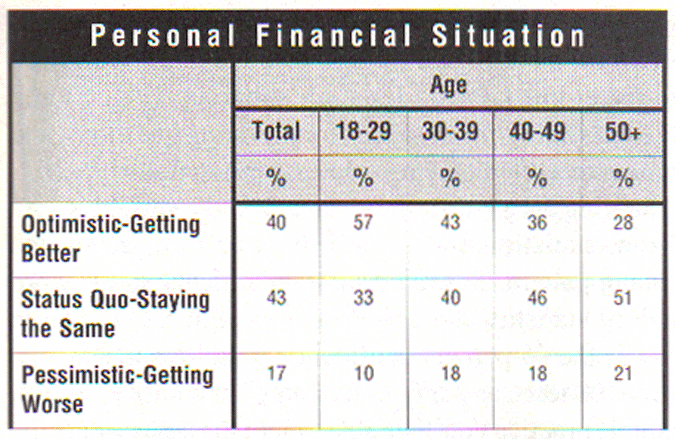
A correlation between age and positive change in personal financial situation is evident. Younger consumers (18 to 29 years old), who are new to the job market, have experienced the greatest positive change. The percentage goes down as age goes up. Older age groups see their financial situation for the most part as status quo.
The next six months - An equal number of consumers feel their income will be unchanged (49 percent) as say they expect their income to increase (45 percent). As few as 5 percent feel their personal income will decrease.
Most likely to be optimistic about increased incomes are the 18- to 29-year-olds. Those expressing the greatest stagnation in income are the 50+ group.
Most credit card owners feel they have the same (41 percent) or less money (33 percent) to spend. Twenty-six percent say they have more.
Eighteen- to 29-year-olds exhibit the greatest perceived increase in disposable income. Forty-one percent say they foresee more money in their pockets.
The survey identified two groups of credit card users, the Transactors and the Revolvers. Nearly four in ten (37 percent) credit card owners state they always pay the total balance (on average, $399), due on their cards each month. These are the Transactors. For the most part Transactors are older and in higher income groups. They are in control and smart about their credit card usage. They are using credit cards less often or at the same frequency as a year ago. They are more likely to have credit cards with no annual fee as well as take advantage of credit cards that offer rebates.
Credit card companies find their most profitable customers to be the Revolvers, those who carry balances on their credit cards and pay interest on these balances. Sixty-three percent of card owners have revolving debt on average balances of $2,092 per month. Driving this average up are those Revolvers (38 percent) who carry high average balances - $4,558 per month. The majority of Revolvers (62 percent) carry more modest average balances of $613 per month.
Revolvers perceive themselves as prudent in their use of credit cards. For example, they usually pay more than the minimum due but less than the total balance. They profess to using their credit cards less or at the same frequency as a year ago. They say they have fewer credit cards than they had a year ago. They claim they pay in cash whenever they can. And, they claim they use credit cards for unexpected purchases, special purchases not budgeted purchases.
However, this group exhibits high revolving debt in contrast to their perceived use. One-quarter (24 percent) say they worry about how they will pay off their credit card debt. Unlike the Transactors, Revolvers express a lack of control in their credit card spending. Thirty-two percent of them agreed with the statement "I don’t like using credit cards; I feel like I’ll lose control over my spending," while only 19 percent of Transactors felt the same way. Twenty-two percent of Revolvers are afraid they would overspend if they had a higher limit on their cards; 10 percent of Transactors share the same fear.
